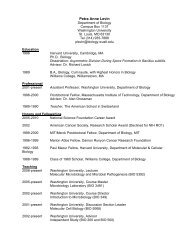Guide for doing FRAP with Leica TCS SP2 - Biocenter
Guide for doing FRAP with Leica TCS SP2 - Biocenter
Guide for doing FRAP with Leica TCS SP2 - Biocenter
Create successful ePaper yourself
Turn your PDF publications into a flip-book with our unique Google optimized e-Paper software.
<strong>FRAP</strong>Note: Alternatively, a second cell, which does nottake part in the <strong>FRAP</strong> experiment, can be used as anindependent control. In this case the ratio F precell /F infcell would be determined <strong>for</strong> this cell.Note: F precell /F infcell can only be accurately determined<strong>for</strong> a closed compartment <strong>with</strong>out exchange<strong>with</strong> the surroundings <strong>with</strong>in the time-scale of theexperiment (s.a. the nucleus in our live cell example).In spite of this limitation the data from the FITCdextranexperiment was used here, <strong>for</strong> illustrationpurposes only.NormalizationNormalization means to rescale the images in a waythat represents plateau fluorescence as 100% (fractionalfluoresence intensity) in order to make severalimage series mutually comparable as well as to enableus to readily estimate the relaxation half-time t 1/2 .The most commonly employed normalization usedwas introduced by Siggia et al. (2000). Here everyframe (time point) is divided by the first frame (timepoint). This way Pre-Bleach intensities will be normalizedto 100%. This type of normalization is suitable tographically determine the mobile fraction from normalizeddata, while the relaxation half-time can not.This method can also be applied to incomplete recoveries(i.e. fluorescence intensity has not reached aplateau value.).Figure 3Schematic cell expressing GFP mainly in the nucleus. A region is bleachedin the nucleus (red circle). After the bleach pulse the cell isimaged at low intesity to follow the fluorescence recovery. Pre-Bleach shown <strong>with</strong> Bleach ROI (region of interest) as well as furtherquantification ROIs (not drawn to scale).of the data set by (F precell /F infcell ), where F precell meansprebleach intensity <strong>with</strong>in the whole cell, F infcellstands <strong>for</strong> postbleach intensity (whole cell minusBleach ROI) at any given time point. This correctionshould be done after subtraction (see above). In anycase, it is preferable to optimize the experimentalparameters in order to avoid strong photobleaching.An acceptable range would be between 5-15% fluorescenceloss.An alternative method was published by Axelrod et al.(1976).Fn(t) = (F(t) – F(0))/(F(inf) – F(0)) (1)WithF(t)..fluorescence intensity at time t inside bleach ROIF(0)..fluorescence intensity at time 0(immediately after bleaching)F(inf)..fluorescence intensity at equilibriumUsing the “Axelrod method” the plateau value is setto 100%. There<strong>for</strong>e, the relaxation half-time can begraphically determined from a normalized plot, whilethe mobile fraction cannot be determined.The following sections introduce methods <strong>for</strong> <strong>for</strong>malestimation of mobile fraction and relaxation half-times.Confocal Application Letter 7











